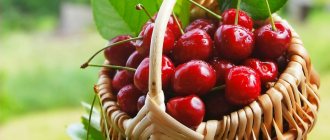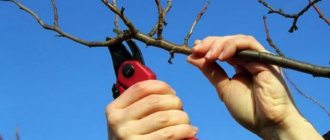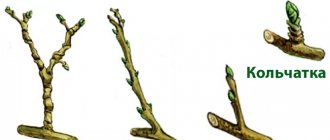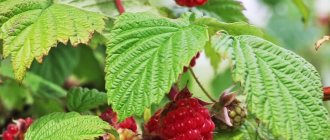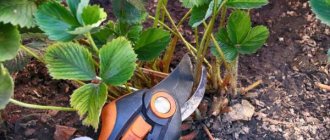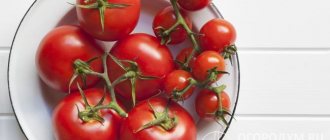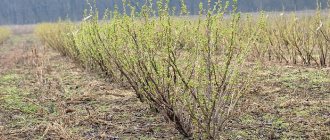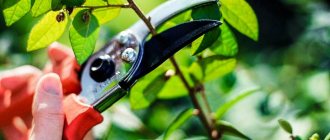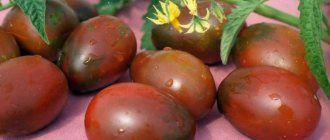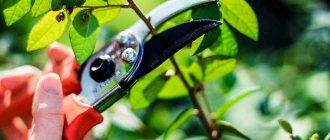Pruning raspberries after fruiting has ended is the key to a good harvest next year.
A few words about the plant: a subshrub whose rhizome has a large number of adventitious roots. From them in the spring, stolons emerge, which give rise to new shoots.
The bush consists of young shoots and two-year-old stems. Fruiting in remontant raspberries begins immediately in the first year, while in ordinary raspberries only in the second season.
Why prune raspberries in the fall?
Non-repairing raspberry varieties are characterized by a 2-year development cycle - young plants bear fruit only in the second year. Only on two-year-old shoots will flower buds form, and only on them will there be berries. One-year-old young shoots have only leaves. The branches, having bear fruit in the second year of life, produce significantly fewer berries in the third year, many dry out and die.
The gardener’s task is to promptly eliminate fruit-bearing branches. Why is it important to prune them in the fall:
- The young growth that grows to replace the old branches will receive the proper amount of light and nutrients - this will allow them, having become stronger before winter, and without freezing, to survive the winter safely.
- The number of pests that move to winter not only in the soil and fallen leaves, but also in dead stems is reduced. The latter often become a source of mold and fungi.
Autumn pruning is also aimed at combating growth - if it is not removed, the raspberry bush will quickly run wild and turn into thickets. Shoots growing from rhizomes grow quickly in warm weather. One bush produces up to 20 shoots, which draw juices from it, preventing normal fruiting.
Reasons for fighting shoots:
- It is difficult to pick berries in the raspberry wilds.
- There are few berries and they become smaller - the yield of the bushes decreases.
- An obstacle is created to the free circulation of air and the penetration of sunlight - this contributes to the development of diseases and causes the appearance of pests.
- The root shoots can move 3 m or more away from the mother bush - this leads to the “spreading” of the plantings.
Exact terms and conditions of pruning
Autumn is considered the best time to prune raspberries. The main thing is not to postpone this event until frost. When the harvest ends, many pests accumulate on the bushes - it’s time to destroy them by pruning and eliminating excess branches by burning. Otherwise, these shoots will be parasitized by insects that nourish their bodies before wintering.
Deadlines by region
After pruning, there is still a month and a half left before frost, during which time the plants have time to accumulate nutrients for the future harvest. Table 1 shows the timing of autumn pruning for different regions of Russia.
Table 1
| Region | Timing of pruning |
| Middle lane | from the second ten days of August to the second ten days of September |
| Ural and Siberia | throughout August |
| South of Russia | from mid-July to mid-October |
Raspberries are pruned no later than three weeks before freezing temperatures set in.
When choosing a pruning time, consider the forecast for your area. It may be necessary to adjust the dates due to the early cold weather.
The timing of pruning also depends on the type of raspberry:
- On ordinary raspberries, pruning is carried out after picking the berries - the exact timing is difficult to determine in advance; the onset of frost must be taken into account.
- There is no rush to prune remontant raspberries - they bear fruit until late autumn. Typically pruning is done after the leaves have dropped.
Dates according to the lunar calendar
Pruning of raspberry bushes is carried out during the waning Moon, in the 3rd and 4th phases. During this period, the juices in the plants move from the growth point towards the roots - under such conditions pruning is most favorable. It is not recommended to prune raspberries during the full moon, new moon or on the 23rd lunar day.
In the fall of 2022, it is best to prune raspberries on the following days:
- September 2, 5, 7, 9, 20 and 28;
- October 1, 4, 5, 10, 29, 31;
- November 3, 7, 8, 11, 28, 30.
The 3rd, 6th and 8th lunar days are favorable for any work, including pruning bushes.
It is not recommended to prune bushes:
- October 1 and 28;
- November 1st and 26th.
The best moon days for pruning bushes are in Aries, Leo and Sagittarius.
Dates according to the lunar calendar
The lunar calendar is a special set of rules that is often used by summer residents and gardeners. The position of the moon affects the growth and development of plants on earth. Gardeners who follow a lunar pruning schedule prefer not to disturb the bushes when they are in the resting stage or continue to sprout. The best option is to choose a period when the underground part of the bush develops.
This period falls on the second and third phases of the waning moon. Specific dates for when to start pruning raspberries in the fall can be found using a special lunar calendar, which is compiled and published annually for summer residents and gardeners. Typically these dates fall in the first two weeks of September.
Procedures on new and full moon days are completely excluded. These days are called rest days. According to the set of rules of the lunar calendar, if you prune a bush on a new or full moon, you can greatly weaken the plant. At this time, the bush is in its weakest position, it is not protected and reacts to external interference with a significant decrease in overall immunity.
Necessary equipment
All instruments are prepared in advance - sharpened and disinfected. Dull cutting parts will damage the branches, impairing the frost resistance of the bushes. An undisinfected instrument can carry various diseases, infecting raspberry bushes.
Tools required for cutting:
- Secateurs. The main device for removing excess branches and growth. It can be replaced with pruning shears.
- Lopper. Can be useful for trimming thick stems.
- Garden knife. Necessary for correcting unsuccessful, uneven pruning.
- Rake. They are used to remove trimmed branches and leaves.
What tools are needed
Full pruning can only be done with the help of constantly disinfected sharp pruning shears. A tool with dull blades will do a disservice, as it will crumble and damage the branches, which will affect the winter hardiness of the entire plant. But the disinfection process is needed to exclude the possibility of spreading diseases to other shoots. Any disinfectant will do.
When working with secateurs in raspberries, do not forget to wear gloves!
Basic Rules
Autumn pruning combines the removal of infected, damaged and dry shoots with the complete elimination of shoots. The event is carried out in compliance with several technical rules, the same for any variety of raspberries.
Technique
When pruning in autumn, it is important to follow these rules:
- To avoid thickening of plantings and excessive foliage, pruning is planned so that the branches do not overlap each other, but are arranged in a fan.
- First, all two-year-old shoots are removed. This is done immediately after harvesting. And they cut them off to the very root.
- Broken and damaged branches are also removed to the very roots, not even leaving stumps. Damaged branches, if left, will take a lot of energy from the plant, and the berries will still grow small and tasteless.
- Whether to remove annual shoots or not depends on the climate. During warm winters, they can be left tied in bunches so that the wind does not fray. In regions with harsh winters, young growth is pruned and plantings are covered. Young shoots, not having time to become woody, often freeze and die.
- Shoots that grew in the middle of summer are removed - they are too weak to survive the frost.
At what height is the pruning done?
How to determine the cutting height:
- The tops of young shoots are trimmed so that the height of the shoots is 1.2-1.5 m.
- If young shoots are poorly developed, they can be pruned to 1 m.
- Weak tops are cut off to the first healthy bud.
- Approximately 25 cm is removed from each branch.
The result will be a planting in which all bushes will have equal height.
Answers to frequently asked questions
Why is there no harvest for several years after pruning?
This problem can arise if the summer resident has cut off the young shoots, leaving the old ones. Branches that bear fruit next year will not form berries. Therefore, it is recommended to carefully inspect the bushes and remove specimens with woody bark.
Why do raspberries get sick after pruning?
Before pruning, you need to carefully inspect the tools. To trim raspberries, sharp pruning shears that have been disinfected are used. Often, when using low-quality tools, plants are exposed to fungal infections.
Why did the berries become small?
This problem can arise if the raspberries were pruned incorrectly in August after harvest. If the bushes are too dense, the raspberries become smaller and ripen unevenly.
Why are there no young branches in spring?
If the gardener is not careful when pruning, the buds are often damaged. As a result, fruiting is reduced and young branches develop poorly.
Why does the raspberry tree thicken so much in the spring?
The reason is improper pruning. Plants must be kept at least 1 meter apart between bushes. Otherwise, the side shoots make the raspberry tree dense and unkempt, and fruiting is reduced.
Methods for pruning raspberries
Raspberry varieties differ in the type of fruiting, shoot growth rate, frost resistance and other varietal characteristics. Depending on the latter, the optimal pruning method is chosen.
In fast-growing raspberries, the shoots are shortened more than in varieties with normal growth.
Regular pruning
In raspberry fields that are not cultivated in the summer, all pruning work is done in the fall. Pruning conventional raspberry varieties comes down to removing shoots:
- broken;
- damaged by diseases and insects;
- two-year-olds;
- parts of annual shoots - to thin out the berry patch.
All of the above branches are removed completely - to the root.
An overview of autumn pruning of raspberries can be seen in the video below:
Pruning remontant raspberries
Remontant varieties, unlike ordinary ones, produce several harvests per season. They bear fruit not only on two-year-old shoots, but also on one-year-old shoots. These features must be taken into account when pruning. The Sobolev method is used here after the last harvest. But autumn pruning is carried out only in the southern regions; in the northern regions and in Siberia, remontant raspberries are pruned in the spring.
Autumn pruning of remontant raspberries is carried out only after the last wave of fruiting has stopped. It does not always happen that there are three weeks left between the end of fruiting and frost, since remontant varieties tend to bear fruit until late autumn.
Autumn pruning of remontant raspberries:
- The 2-year-old branches that bear fruit are cut to the surface of the ground.
- Annual shoots are shortened by 20 cm. The cut parts are raked and burned, and the bushes themselves are sprayed with Bordeaux mixture.
- In the spring, before the buds open, sanitary pruning is carried out, cutting out all frozen, dry and broken branches.
There are two types of pruning of remontant raspberries:
- For one harvest. This option is usually chosen for commercial cultivation - if the gardener wants to get one harvest, but as abundant as possible. The essence of the method: After waiting for the first frost, all bushes are cut off at the root. If pruning is done earlier, young growth will sprout, freeze, and the raspberry tree will die.
- In spring, young plants are carefully thinned out, leaving 3-4 stems per bush.
- First, after the first harvest of berries, two-year-old branches that bear fruit are cut off at the root. All the same, next year there will be little fruit for them.
If you add up the volume of two harvests, it will be comparable to the productivity of conventional varieties that produce one harvest. At the same time, the shelf life of the fruit improves.
Pruning the Cumberland variety
Cumberland is a variety of black raspberry whose shoots grow extremely quickly. This means that the usual methods of pruning Cumberland and similar raspberries will not be enough. The usual approach will lead to thickening of the planting, the bushes will look overgrown, and their immunity and productivity will drop. To maintain the normal condition of the bushes, this black raspberry will require two prunings per season.
After watching this video, you will learn how to prune the Cumberland raspberry variety:
Cumberland pruning scheme:
- The first pruning is summer. Its goal is to increase productivity. The optimal time is the end of June. Young growth is trimmed at the growth point. Their place next summer will be taken not by one new branch, but by several fresh shoots at once. In practice, it has been proven that one bush can produce an excellent harvest - without losing the size and taste of the berries, with 10-12 fruiting shoots. Stems over 2 m high are cut by 10%. This must be done on time, since the growing side shoots, if the pruning is delayed, will not have time to fully develop and will die in the winter.
- The second pruning is autumn. This is sanitary pruning, which begins when the plant goes into a dormant period. This time, depending on the region, occurs from mid-October to early November. The order of autumn pruning: cut off broken, damaged, diseased and dry shoots;
- thin and weak shoots growing deep into the bush or downwards are also removed;
- excessively long shoots that exceed the height of the trellis are cut to its size (remove up to 1/3 of the length of the branch, no more);
- last year's side shoots are shortened by 20-30 cm - they will produce berries next year;
- branches 2-3 years old are cut as close to the ground as possible, leaving no more than 10-12 shoots.
Gardeners are often afraid to trim Cumberland right down to the stumps, but this is the method that allows them to achieve a good harvest.
Trimming scheme according to Sobolev
The method of Sobolev, a famous amateur gardener from Kurgan, became known in the 80s of the last century. An enthusiast spoke about it in the magazine “Homestead Farming”. The method made it possible to increase productivity - 135 kg of berries were collected from a control plot of 50 acres, which was a lot for those times.
Sobolev improved double pruning by making some adjustments to it:
- According to the Sobolev method, the tops of the shoots are also pruned in the month of May, leaving stems 1 m long. The roots will easily cope with the nutrition of the above-ground part, and the shoots will not break under the pressure of the wind.
- The following spring, two operations are performed at once in one approach - they cut off the tops of young shoots and side shoots that grew last year.
- By July, the raspberry tree, processed according to the Sobolev method, consists of: annual flowering stems;
- branching two-year-old shoots with many flowers, ovaries and berries;
- young growth.
Pruning raspberries using the Sobolev method is presented in the following video:
The disadvantage of this method is the intensive overgrowth of bushes, thickening the plantings. Ventilation of the raspberry tree decreases, most branches are shaded, and the risk of pests and infections increases. To prevent thickening, an interval of 1 m is maintained between bushes, and 2 m between rows.
Formative pruning is carried out as follows:
- In the first year, no more than a dozen branches are left on the bush.
- In the second year, fruit-bearing shoots are replaced with fresh ones, but the number of branches is reduced to 8.
- Every year the number of replacement stems is reduced by 2 pieces.
- The final stage of bush formation involves 4 young branches.
Sobolev’s method increases productivity, but requires thorough thinning of the berry garden throughout the entire growing season - excess growth must be trimmed off in time.
The Sobolev method allows you to collect up to 6 kg of berries from one raspberry bush.
Raspberry care
Raspberry bushes reproduce using the root system. Under good conditions, raspberries produce many shoots, whose lifespan is limited to two years. In the first year, the shoots continue to develop and grow without producing fruit. Only in the second year do they become lignified and bear berries, soon after which they wither, giving way to young shoots.
Shoots of raspberry bushes develop within two years, after which they wither
In order for the bush to take root better on your site, you must follow a number of important rules:
- It is advisable to give raspberries a special place, located on the sunny side and maximally protected from strong winds;
- If you are going to plant a bush in the fall, you should start preparing the soil a month before this event. If you stopped at spring, then the land is cultivated in the fall, so that when the snow melts it will be ready for work;
- Raspberry bushes require periodic irrigation with water, especially in regions prone to dry and hot summer climates. With a lack of moisture, the bushes risk simply drying out, however, an excess of water will destroy young stems;
It is important to ensure that your raspberry bushes receive enough moisture.
- To achieve fertility of the bushes, it is necessary to fertilize the soil on which the raspberries grow. Summer residents often prefer wood ash as a fertilizer;
- A rich harvest has its pitfalls - with a large number of berries, raspberry bushes tend to break. To prevent such consequences, it is recommended to tie up raspberries. To provide the bushes with support, you need to drive two wooden sticks and attach shoots to them at different heights. The result is a design that vaguely resembles a fan.
Raspberry garter will help it keep its branches intact under the weight of the fruit.
Wood ash prices
wood ash
What to do after pruning?
After pruning, the bushes need support in the form of fertilizing and watering so that they can more easily survive stress. Activities after autumn pruning of raspberries:
- Feeding. Add compost, peat, and bird droppings solution. You can add superphosphate - 50 g, and potassium sulfate - 40 g per bush.
- Watering. After feeding, the raspberry tree is watered abundantly. Watering rate is 50-60 liters of water per bush.
- Spraying. Remontant varieties are sprayed with Bordeaux mixture for disinfection. Regular raspberries are sprayed with fungicides in the spring.
- Mulching. After absorbing moisture, the plantings are covered with a thick layer of mulch. They use any organic matter, but for the winter, it is best to sprinkle the soil with pine needles - it will not only protect the plantings from frost, but also from rodents.
- Shelter for the winter. Gardeners in the southern regions and the Middle Volga region may not cover raspberries for the winter - if the variety is zoned in these regions. In areas with harsh winters, it is recommended to cover the berry garden. To do this, the branches are tied into bundles and bent to the ground. If the winters have little snow, the plantings are covered with leaves - a layer of 30 cm. If the raspberry plant is covered with a film on top, ventilation holes must be made in it.
You can’t cover raspberries too early - they run the risk of drying out. If you delay with the shelter, the branches will become brittle and you won’t be able to bend them down.
Post-procedure care
After harvesting, the raspberry plant needs special care and preparation for winter.
Watering
Raspberries love moisture, but in moderation . When there is an excess of it, the root system begins to rot. After harvesting, the raspberries are generously shed with water to a depth of 40-50 cm. This type of watering is called moisture-recharging. It helps the plant to survive the winter. In the spring-summer period, the bushes are watered 5-6 times.
In August - September, watering is stopped so that the plant completes growth and prepares for wintering. In arid areas, winter watering is carried out in October - 50-100 liters per 1 m².
Top dressing
After harvesting, especially in the 2-3rd year of fruiting, raspberries need fertilizing with potassium, phosphorus and nitrogen. It is important to maintain a balance of minerals - both excess and deficiency are dangerous.
Reference. When there is an excess of nitrogen, the raspberry bark cracks and is damaged by gall midges and purple spot. As a result, resistance to frost decreases.
Phosphorus-potassium compounds are applied in late summer - early autumn . Gardeners prefer to use potassium without chlorine: 30-60 g of potassium sulfate, 20-30 phosphate rock per 1 m². Wood ash is especially popular due to its balanced content of potassium and phosphorus - 100 g per 1 m².
After applying fertilizers, the soil is mulched with compost or peat with a layer of 2-3 cm. Organic matter is added every year - 2-3 kg per 1 m² - or every other year - 4-6 kg per 1 m². On depleted soils, raspberries are fed with organic matter annually - 10-15 kg per 1 m². It is recommended to use rotted manure or compost. Organic matter is scattered between rows in a layer of 5-15 cm.
Raspberries respond gratefully to microfertilizers with magnesium and boron . With magnesium deficiency, the leaves turn yellow from the center to the edges and fall off prematurely. If there is a lack of boron in the spring, buds and side branches do not form. In the fall, the bushes are fertilized with magnesium sulfate - 25-35 g per 1 m², and in the spring they add borax - 1.5-2 g m².
After harvesting, it is recommended to check the acidity of the soil . Raspberries grow best on soil of medium mechanical composition and humus. On light, low-humus soils, deoxidation is performed with dolomite flour 40-50 g per 1 m², on neutral and excessively acidic soils - 600 g per 1 m². Dolomite flour also serves as a source of magnesium.
The soil in the tree trunk circle is loosened, weeds and plant debris are removed . They work with a hoe within a radius of 1 m from the center of the bush, at a depth of 5-7 cm, so as not to damage the roots, which are located below 8-10 cm.
Preparing for winter
After pruning raspberries at the end of the fruiting season, gardeners begin preparing for winter . If there are leaves left on the shoots, they are carefully removed, leaving the buds. The branches are then tied in bunches using metal staples and bent to the ground.
The most dangerous zone is located at a height of 50 m from the ground surface ; it is here that shoots are often damaged by frost. In most Russian regions in January, the thickness of the snow cover does not exceed 40 cm. The shoots are uncovered in the zone of concentration of frosty air. Therefore, for reliability, the bundles are covered or wrapped with non-woven material - agrofibre or tarpaulin.
To protect against rodents, bushes are covered with barbed wire, netting, spruce branches , and poisonous baits are laid out. Gardeners in the northern regions are advised to bend the branches as close to the ground as possible and cover them with straw. In windy areas, snow protection is constructed from plywood or polycarbonate on the leeward side.
Reference. The branches are bent at an air temperature of +10°C, since they break in the cold.
Prevention of pests and diseases
The main pest of raspberries is the shoot gall midge, or raspberry mosquito . To completely get rid of the pest, it is recommended to dig the plantation deeply and incorporate mineral fertilizers into the soil. Pesticides must not be used after harvesting.
Preventive treatment against fungal infections is carried out using Bordeaux mixture with an admixture of laundry soap for better stickiness.
Free soil between rows is dug up deeply to destroy pest nests. This is effective against the flower beetle (raspberry-strawberry weevil), stem fly, shoot gall midge, and spider mite.
Plant residues are carefully collected, taken outside the plantation and burned . They hide the larvae of weevils, raspberry stem and shoot gall midges, pathogens of septoria, purple spot, rust, and anthracnose. Mulching with a thick layer helps protect bushes from insects and fungal infections.
Do I need to prune remontant raspberries before winter?
In regions with harsh winters, it is recommended to cut off all shoots - annual and biennial, being careful not to leave stumps. Then the autumn harvest will be as abundant as possible. If the gardener wants uniform fruiting - in two stages, then annual shoots are left for the winter.
True, in regions with harsh winters they must be covered. If you don’t want to bother with the shelter, then it’s better to cut off everything – both two-year and one-year-old shoots. And only in the south is it better to leave annual trees for the winter without pruning them.
In the video below, the gardener shares his experience of preparing remontant raspberries for winter:
How to ration raspberries in August?
During pruning in August, it is recommended to carry out normalization. The following rules must be observed:
- carefully examine the shoots and remove crooked and unripe ones;
- in order to increase fruiting, 10 ripened branches are left per 1 linear meter;
- the main fruiting specimens should be no more than 1 cm thick;
- No more than 6 branches are left on the bushes for shelter.
Normalization should be carried out in August before the main pruning.
Gardener mistakes
Most novice gardeners often make mistakes when pruning raspberries. Most often, beginners make the following mistakes:
- It is a pity to cut off strong young growth - beginners think that by cutting it, they are depriving themselves of the future harvest. This “psychological barrier” must be overcome - without pruning, the plantings will become sick, the berries will become smaller, and the yield will fall. This is the biggest and most common mistake novice gardeners make.
- Not all branches to be pruned are removed. Beginners often start pruning from the outer branches. When cutting out young shoots, they remove mainly the outer shoots without going deep into the berry garden. As a result, the center of the raspberry tree becomes thickened - this leads to a decrease in yield and the appearance of diseases. Be sure to be patient and remove shoots in the center of the plantings.
- Do not remove intertwined branches . By not pruning branches that are close to each other and intertwined, gardeners increase the risk of disease. When branches come into contact, they lose their protective layer and become vulnerable to microbes.
- Incorrect pruning pattern . Often gardeners only shorten shoots that should be cut off completely. They cut out only dry and broken branches and leave the rest. Sanitary pruning is not enough - formative pruning is also needed, on which the future harvest depends.
- When pruning, the buds are damaged . To prevent this from happening, it is important to follow the pruning pattern. First, remove all large branches, then the smaller ones. Then pruning goes faster and without damaging the buds.
Why do you need to cut shoots?
Beginning gardeners are tormented by the question of whether they need to prune raspberries in the fall. We answer: if you leave the shoots of the plant at full growth, then a decrease in yield and a decrease in the size of the berry are guaranteed. The remaining dry shoots do not allow young shoots to grow. Pruning is required for all raspberry varieties and promotes the appearance of new shoots in place of the fruit-bearing ones. Plants older than two years should be removed.
It is important to control the distance between plants; gaps are necessary for uniform sunlight and ventilation
Dense thickets directly affect the yield: a lot of greenery - few berries. This also affects the taste - the sweetness disappears, giving way to a sour taste. Numerous pests indulge in the fragrant raspberry forest, bringing with them various diseases for the plant to their new place of residence. Young shoots, which are a consequence of lack of pruning, do not have time to ripen and die before spring arrives.
Pruning raspberries for the winter is a mandatory process that will provide you with a harvest of large and tasty raspberries.
When is it better to prune, autumn or spring?
Autumn pruning can be replaced with spring pruning in regions with relatively warm winters. But you need to be sure of good snow cover so that the young shoots left for the winter do not freeze out. If they freeze, the gardener will suffer losses. From the point of view of raspberry plant safety, autumn pruning looks like a more reliable agricultural measure.
In general, raspberries are pruned several times a season. During the growing season, one root can produce up to two dozen young shoots. In spring, pruning is carried out for sanitary purposes and to awaken the buds. In autumn - for the purpose of forming a bush and to prevent freezing. Therefore, both options are important for raspberry growers.
Why spring pruning is needed:
- This is a continuation and addition to the pruning done in the fall.
- It starts immediately after the snow melts. Remove all shoots that the bush does not need - weak, diseased, frozen over the winter, broken. Trim them as low as possible, without stumps.
- Then the tops are cut off - if the shoots were left for the winter, by 20 cm, to healthy buds. This causes the awakening of the upper buds, forming 3-6 shoots with berries. If the tops are not cut off in the spring, the berries will be small.
As you can see, spring pruning pursues its own goals, and one cannot refuse it. Moreover, it is recommended to prune raspberries in the summer. By cutting off wilted or diseased tops during the flowering period, gardeners prevent infection of neighboring bushes. Also in the summer, shoots are removed, preventing the depletion of raspberry bushes.
Gardening Tips and Tricks
In order to increase the fruiting of berries, it is recommended to use the following tips from experienced summer residents:
- trim in the evening. This will prevent the foliage from wilting;
- after pruning, water the raspberry tree thoroughly;
- After the procedure, carefully collect the remaining foliage and shoots. Otherwise, larval eggs may accumulate in the soil;
- if raspberries are grown near trellises, it is necessary to make a garter in a timely manner. Otherwise, the branches are damaged during the winter.
During the season, it is recommended to closely monitor the condition of the raspberry plant. This will further facilitate the process of caring for berry bushes and increase fruiting.
How does autumn pruning differ in different regions?
The differences in pruning are related to the climate; it is he who makes adjustments to its technique:
- In the central regions of the Russian Federation and in the Moscow region in particular, young shoots do not need to be pruned for the winter. It is enough to tie them and cover them. This method allows you to use snow as a natural insulation. But the use of artificial covering materials can be harmful - condensation often forms under it, which provokes the development of fungal diseases.
- In Siberia, autumn pruning is a mandatory agrotechnical activity. The winters here are so cold that you can’t do without shelters, and pruned bushes make it quick and easy to cover your raspberry patch.
- In the Krasnodar Territory, pruning is carried out in late autumn. Gardeners have time to get another autumn harvest. True, autumn raspberries are small and there are very few of them, but it’s still nice when the bushes continue to bear fruit at such a late time.
Raspberries are unpretentious and bear fruit under any conditions, but if you are interested in a good harvest, in large and sugary berries, then do not be lazy to trim the raspberries on time. You should pay special attention to autumn pruning - it is important to correctly calculate the timing and follow the technique of this important agricultural activity.
0
0
Copy link
